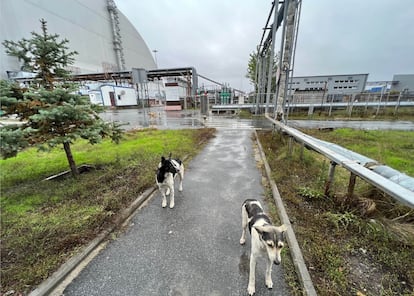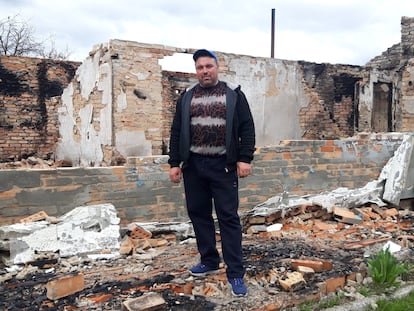Chernobyl’s stray dogs are genetically different
A study shows that the dogs are distinct, but the explosion of flora and fauna in the affected area has raised questions about whether it’s due to radiation

A genetic analysis of the dogs living near the Chernobyl Nuclear Power Plant in Ukraine shows that they’re different. However, there’s no proof that this is due to radiation.
A study carried out on more than 300 feral dogs indicates that the genetic affinity changes as the distance to Reactor Number 4, which exploded in 1986, increases. However, these differences could be due to causes that aren’t related to the release of radioactive material. In fact, the area around the plant is witnessing a massive explosion of wildlife.
On April 26, 1986, Reactor Number 4 of the Vladimir Ilich Lenin power plant in the Chernobyl district – 10 miles from the city of Pripyat, in the north of the Ukrainian Republic in the Soviet Union – exploded. This was the biggest nuclear accident in history. For days, large amounts of radioactive material – such as cesium-137, iodine-131 and other radionuclides emitting ionizing radiation – were burned and released into the atmosphere.
Weeks later, the Chernobyl Exclusion Zone – consisting of a radius of 1,000 square miles from the plant – was evacuated of all inhabitants. As part of this containment program, the Ukrainian Ministry of Interior – then under the jurisdiction of the Soviet Union’s government – ordered the euthanization of all pets. But some dogs escaped the purge.
How have the descendants of these dogs managed in an environment that was initially so dangerous? According to the numbers, they seem to have fared quite well. Currently – according to the Chernobyl Dog Research Initiative’s census – there are more than 800 feral dogs in the area. For Tim Mousseau, a biologist at the University of South Carolina and senior author of this new study, “anything we learn about how they survive in this environment will be of direct relevance to humans in Chernobyl and other radioactive environments.”
The team took blood samples from 302 specimens. Almost half live around the power station and Prípyat, which has become a ghost town. Another 150 are from Chernobyl itself: 10 miles from ground zero. And the remaining 16 roam Slavutich – also a Ukrainian town, but 27 miles away from the blast site, well beyond today’s exclusion zone.
The blood from the samples has allowed the scientists to map genetic similarities. The results of this work – published in the journal Science Advances – indicate that these dogs are genetically different from other dogs from various countries that were analyzed for comparison. Some samples also came from stray dogs captured in Vinnitsa, a Ukrainian city located over 200 miles southwest of Chernobyl.
The study goes even further: the animals in the study are grouped into three large populations from the genetic point of view. Belonging to one group or another depends on the distance from the nuclear plant. This suggests that radiation exposure might have affected the genes of some dogs more than others. But there’s no data, for now, to support this having occurred.
In principle – and being highly dependent on the dose and exposure time – ionizing radiation causes oxidative stress, cell and DNA damage, among other effects. However, the authors of the work have not published any data indicating alterations in the dogs.
Mousseau has been going to Chernobyl for twenty years (until the Russia-Ukraine war broke out), almost as long as he’s been warning of the damage that the radiation is causing. “We’ve carried out preliminary studies of the external and internal doses [received by] these dogs, and we have an article under review that covers part of this question,” Mousseau clarified in an email to EL PAÍS.
One of the problems with the thesis of this biologist, an expert on the impact of the environment on genes, is that it runs up against reality. After the 1986 disaster, which must have cost the lives of countless living beings, the exclusion zone has become a kind of paradise on earth. After the evacuation of the Adams and Eves and the abandonment of the fields, both the flora and fauna have thrived in the entire area surrounding the power station.
A work published in 2015 revealed that, indeed, the presence of large mammals was reduced in the first years after the accident, but they eventually recovered. Aerial surveys conducted since the 1990s show that moose, deer and wild boar populations were similar to those in other regions not affected by the disaster. And, with the absence of humans, the wolf population had increased sevenfold, with the highest population density in Europe.
“Many studies now suggest that, in the parts of the exclusion zone that are not particularly radioactive, many animals have done very well, especially those that are hunted in other areas outside the zone,” Mousseau acknowledged. “However, most research clearly shows that many organisms living in the most radioactive regions of the exclusion zone have severe injuries of many types.” We now have to wait for the second part of his investigation – which deals with radioactive exposure data – to find out how the dogs are doing.
Jim Smith is a biologist at the University of Portsmouth (UK) and, like Mousseau, has been going to Chernobyl for several years. He’s the main author of the work on wolves and other large mammals in the vicinity of Chernobyl. He has participated in various censuses of wildlife in the region.
“In our 2015 study, we were unable to find evidence linking mammalian populations to radiation dose. [We also] found mammalian population densities similar to other nature reserves in Belarus,” whose border is less than 13 miles away. “I haven’t studied their situation since then, but other scientists have found similar results,” he added.
For Smith, the genetic part of Mousseau’s research is impeccable, but he rejects that it can be connected to radiation exposure. “All radiation (including natural radiation from rocks, X-ray scanners, cosmic rays) can damage DNA, so the radiation at some Chernobyl hotspots is surely influencing the genetics of animals. But the question is to what extent is it happening and if it significantly affects populations,” he explained. The problem is that there are many other environmental factors, hence “it’s difficult to find clear effects of radiation in individuals, even in the most contaminated areas.” “What’s clear to me is that, in the absence of human pressure, wildlife thrives despite the potential influence of chronic low-level radiation,” he added.
Like Mousseau and Smith, many other scientists from various disciplines from around the world frequently visit Chernobyl. It’s the largest experiment to study the impact of radiation on life. One of these researchers – biologist Germán Orizaola, from the University of Oviedo (Spain) – has a research lab in the city, thanks to a collaboration with the Chernobyl Center for Nuclear Safety, Radioactive Waste and Radioecology.
A few years ago, he published a paper on Przewalski horses. About thirty of these wild equines were released into the exclusion zone in 1998 – 12 years after the explosion – without much ecological logic at first. In the article, Orizaola wrote: “Initial predictions indicated that, due to radioactive contamination, the area would be uninhabitable for more than 20,000 years. It was thought that Chernobyl would become a desert for life. However, at present, there are already about 200 horses.”

Orizaola specializes in the study of amphibians, especially the Eastern San Antonio frog, a small frog with an intense bright green color. In a study published in 2020 with his colleague Pablo Burraco, they discovered that, closer to the power plant, the frogs are darker. The ones in the ponds nearest to the blast site are almost black.
Like Mousseau in his study with the dogs, Orizaola and Burraco measured ambient radiation. But what Mousseau didn’t do (or at least hasn’t published anything about it yet) was measure the radiation existing inside the animals; specifically, the presence of cesium in the muscles and strontium in the bones. While doing this, Orizaola and Burraco found no relationship between the coloration of the frogs and the absorbed radiation dose.
In a note from the University of Oviedo, they explained the apparent mystery: “These results suggest that the differences in coloration are not due to current exposure to radiation. [They] point to the effect of historical exposure of these populations.” In other words, the dark coloration of the Chernobyl frogs could be due to an initial exposure to very high levels of radiation experienced by the frogs that lived there in 1986. Greater levels of melanin protect creatures from radiation. Thus, the darker amphibians would suffer less from radiation, having a greater chance of surviving. Lighter ones may have been wiped out.
“In dogs or in any other animal, the key is to determine the radiation exposure,” noted Orizaola, in one of the criticisms he has made of the study of the Chernobyl dogs. But there are other factors to consider. “The initial number of those who survived the [euthanization project] that began after the explosion is unknown, which introduces the bias of the founding dogs,” the biologist said. A very small initial population favors genetic differentiation. “In addition, the radiation of 1986 has nothing to do with the current one. It’s been reduced by 90% – the most dangerous compounds have disappeared.”
His final assessment of the dog study is summed up in one sentence: “They are as different as the dogs of Warsaw from those of Krakow.” Both those Polish cities are relatively far from the blast site.
Ismael Galván – an ecologist from Spain’s National Museum of Natural Sciences – worked with Mousseau on a study about the birds of Chernobyl. This resulted in a published work in 2014, which came to very interesting conclusions that made quite a stir in the scientific community. The men studied the impact of radiation on 16 species of birds: “Birds improve their levels of antioxidants and their body condition and decrease their levels of oxidative stress and DNA damage with the increase in background radiation to which they are exposed to in Chernobyl.” That is, the birds don’t appear to be negatively affected by mild radiation exposure. Galván emphasized that today “Chernobyl is experiencing an explosion of life.”
Regarding the dogs, Galván acknowledged that the data shows that they’re genetically different from birds, so the radiation hypothesis doesn’t seem problematic to him. “Genetic differentiation may be the basis for the adaptation that we saw in birds. It’s likely that the animals have adapted to low but chronic radiation levels over time, leading to a physiological adaptation.” The problem is that there’s a lack of data on the physiology of dogs.
The key could lie in a term used by toxicologists: hormesis. “When an organism is exposed to something harmful that the metabolism has to fight or face (a chemical agent, environmental damage, radiation), the final state can be better than the initial one,” Galván explained. It’s the scientific version of “what doesn’t kill you makes you stronger.”“It’s obvious that radiation isn’t good, but animals, over the course of generations, have the ability to adapt.”
Sign up for our weekly newsletter to get more English-language news coverage from EL PAÍS USA Edition










































